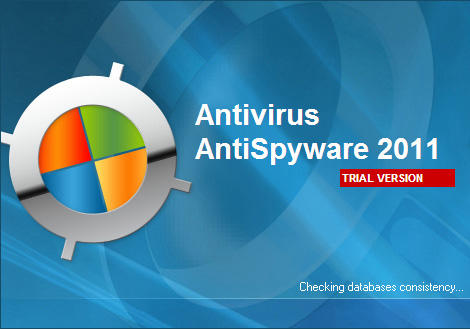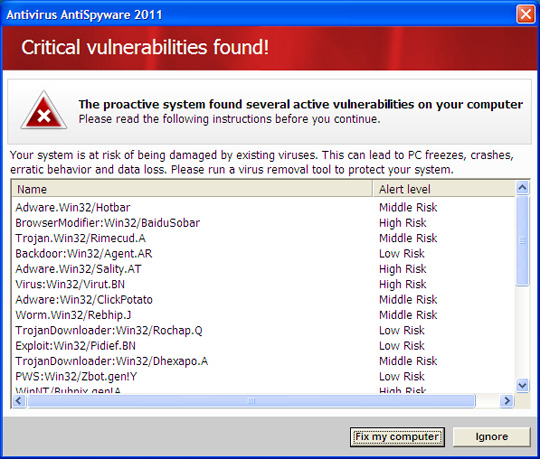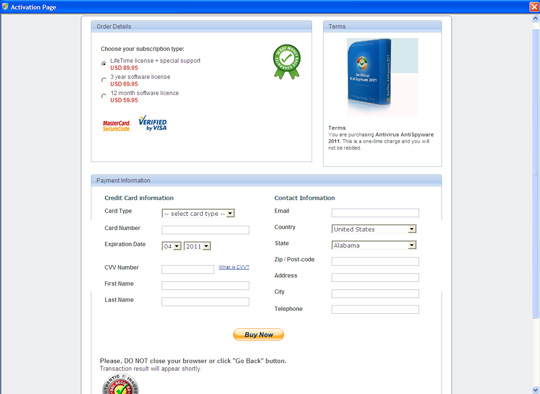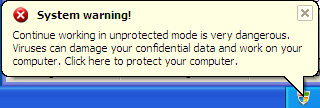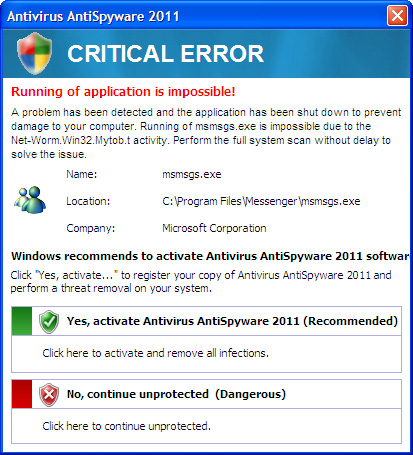TROJ_FAKEAV.BQT
Windows 2000, Windows XP, Windows Server 2003


Threat Type: Trojan
Destructiveness: No
Encrypted: Yes
In the wild: Yes
OVERVIEW
This Trojan may be downloaded by other malware/grayware/spyware from remote sites. It may be unknowingly downloaded by a user while visiting malicious websites.
It installs a fake antivirus/antispyware software. It displays fake alerts that warn users of infection. It also displays fake scanning results of the affected system. It then asks for users to purchase it once scanning is completed. If users decide to purchase the rogue product, users are directed to a certain website asking for sensitive information, such as credit card numbers. When users agree to buy the software, it connects to a certain URL.
TECHNICAL DETAILS
2,606,600 bytes
EXE
Yes
20 Apr 2011
Arrival Details
This Trojan may be downloaded by other malware/grayware/spyware from remote sites.
It may be unknowingly downloaded by a user while visiting malicious websites.
Installation
This Trojan drops the following component file(s):
- %Application Data%\Antivirus AntiSpyware 2011\65.mof
- %Application Data%\Antivirus AntiSpyware 2011\myhlp.chm
- %Application Data%\Antivirus AntiSpyware 2011\weexujds
- %Application Data%\Antivirus AntiSpyware 2011\weexujds\wewlrauzgds.cfg
- %Application Data%\Microsoft\Internet Explorer\Quick Launch\Antivirus AntiSpyware 2011.lnk
- %User Profile%\Desktop\Antivirus AntiSpyware 2011.lnk
- %User Profile%\Start Menu\Antivirus AntiSpyware 2011.lnk
(Note: %Application Data% is the current user's Application Data folder, which is usually C:\Windows\Profiles\{user name}\Application Data on Windows 98 and ME, C:\WINNT\Profiles\{user name}\Application Data on Windows NT, and C:\Documents and Settings\{user name}\Local Settings\Application Data on Windows 2000, XP, and Server 2003.. %User Profile% is the current user's profile folder, which is usually C:\Windows\Profiles\{user name} on Windows 98 and ME, C:\WINNT\Profiles\{user name} on Windows NT, and C:\Documents and Settings\{user name} on Windows 2000, XP, and Server 2003.)
It creates the following folders:
- %Application Data%\Antivirus AntiSpyware 2011
- %Application Data%\Antivirus AntiSpyware 2011\weexujds
(Note: %Application Data% is the current user's Application Data folder, which is usually C:\Windows\Profiles\{user name}\Application Data on Windows 98 and ME, C:\WINNT\Profiles\{user name}\Application Data on Windows NT, and C:\Documents and Settings\{user name}\Local Settings\Application Data on Windows 2000, XP, and Server 2003.)
Autostart Technique
This Trojan adds the following registry entries to enable its automatic execution at every system startup:
HKEY_CURRENT_USER\Software\Microsoft\
Windows\CurrentVersion\Run
wewlrauzgds.cfg = "%Application Data%\Antivirus AntiSpyware 2011\AS2011.exe"
Other System Modifications
This Trojan adds the following registry keys:
HKEY_CLASSES_ROOT\AS2011.DocHostUIHandler
HKEY_CLASSES_ROOT\CLSID\{3F2BBC05-40DF-11D2-9455-00104BC936FF}
HKEY_CURRENT_USER\Software\SE2010
It adds the following registry entries:
HKEY_CLASSES_ROOT\AS2011.DocHostUIHandler
(Default) = "Implements DocHostUIHandler"
HKEY_CLASSES_ROOT\AS2011.DocHostUIHandler\Clsid
(Default) = "{3F2BBC05-40DF-11D2-9455-00104BC936FF}"
HKEY_CLASSES_ROOT\CLSID\{3F2BBC05-40DF-11D2-9455-00104BC936FF}
(Default) = "Implements DocHostUIHandler"
HKEY_CLASSES_ROOT\CLSID\{3F2BBC05-40DF-11D2-9455-00104BC936FF}\
LocalServer32
(Default) = "%Application Data%\Antivirus AntiSpyware 2011\AS2011.exe"
HKEY_CLASSES_ROOT\CLSID\{3F2BBC05-40DF-11D2-9455-00104BC936FF}\
ProgID
(Default) = "AS2011.DocHostUIHandler"
HKEY_CURRENT_USER\Software\SE2010
LastVFC = "{value}"
HKEY_CURRENT_USER\Software\SE2010
LastD = "{value}"
HKEY_CURRENT_USER\Software\SE2010
LastScan = "{date and time}"
Process Termination
This Trojan terminates the following processes if found running in the affected system's memory:
- accesschk.exe
- AccessEnum.exe
- acdseepro3.exe
- acdseepro4.exe
- AcroRd32.exe
- ADExplorer.exe
- ADInsight.exe
- adrestore.exe
- AdvancedDVDPlayer.exe
- aim.exe
- arp.exe
- at.exe
- Autologon.exe
- autoruns.exe
- autorunsc.exe
- Bginfo.exe
- bitcomet.exe
- bitspirit.exe
- bittorrent.exe
- Cacheset.exe
- calc.exe
- chrome.exe
- Clockres.exe
- CloneCD.exe
- cmd.exe
- cmdkey.exe
- computerdefaults.exe
- conhost.exe
- Contig.exe
- control.exe
- Coreinfo.exe
- ctrl2cap.exe
- Dbgview.exe
- defragui.exe
- Desktops.exe
- DevicePairingWizard.exe
- digitaleditions.exe
- disk2vhd.exe
- diskext.exe
- Diskmon.exe
- DiskView.exe
- dmaster.exe
- du.exe
- dxdiag.exe
- efsdump.exe
- eventvwr.exe
- excel.exe
- far.exe
- fdm.exe
- find.exe
- flashget.exe
- freecell.exe
- ftp.exe
- FullTiltPoker.exe
- GOM.exe
- GoogleEarth.exe
- handle.exe
- help.exe
- hex2dec.exe
- hrtzzm.exe
- Icq.exe
- Illustrator.exe
- infium.exe
- ipconfig.exe
- isoburn.exe
- journal.exe
- junction.exe
- LA.exe
- ldmdump.exe
- Listdlls.exe
- livekd.exe
- LoadOrd.exe
- logonsessions.exe
- miranda32.exe
- mirandaim.exe
- mmc.exe
- movefile.exe
- moviemk.exe
- mplay32.exe
- mplayer2.exe
- mplayerc.exe
- msaccess.exe
- msconfig.exe
- mshearts.exe
- msiexec.exe
- msmsgs.exe
- MsnMsgr.Exe
- mspaint.exe
- mspub.exe
- MSWorks.exe
- Nero.exe
- NeroExpressPortable.exe
- netsh.exe
- netstat.exe
- nfs.exe
- notepad.exe
- nslookup.exe
- ntfsinfo.exe
- OIS.exe
- outlook.exe
- pagedfrg.exe
- pendmoves.exe
- Photoshop.exe
- picasaphotoviewer.exe
- pinball.exe
- ping.exe
- pipelist.exe
- PokerStars.exe
- portmon.exe
- powercfg.exe
- PowerDVD.exe
- powerpnt.exe
- POWERPOI.exe
- powershell.exe
- procdump.exe
- procexp.exe
- procexp64.exe
- ProcFeatures.exe
- psexec.exe
- psfile.exe
- psgetsid.exe
- Psinfo.exe
- pskill.exe
- pslist.exe
- psloggedon.exe
- psloglist.exe
- pspasswd.exe
- psservice.exe
- psshutdown.exe
- pssuspend.exe
- qip2010.exe
- QuickTimePlayer.exe
- realplay.exe
- RealPlayer.exe
- RecordingManager.exe
- reg.exe
- RegCloneCD.exe
- RegDelNull.exe
- regedit.exe
- regedt32.exe
- reget.exe
- regetdx.exe
- regjump.exe
- resmon.exe
- RootkitRevealer.exe
- route.exe
- rstrui.exe
- RwcRun.exe
- RWipeRun.exe
- sdelete.exe
- setup_wm.exe
- ShareEnum.exe
- ShellRunas.exe
- shvlzm.exe
- sidebar.exe
- sigcheck.exe
- Skype.exe
- skypePM.exe
- sndvol32.exe
- sol.exe
- spider.exe
- streams.exe
- strings.exe
- sync.exe
- taskhost.exe
- taskkill.exe
- tasklist.exe
- taskmgr.exe
- tcpvcon.exe
- Tcpview.exe
- telnet.exe
- thebat.exe
- totalcmd.exe
- tracert.exe
- trillian.exe
- tvp.exe
- utorrent.exe
- vmmap.exe
- vmware.exe
- Volumeid.exe
- whois.exe
- winamp.exe
- WindowsAnytimeUpgradeUI.exe
- windvd.exe
- winmail.exe
- winmine.exe
- Winobj.exe
- WinRAR.exe
- WINWORD.exe
- wmplayer.exe
- word.exe
- wow.exe
- wscript.exe
- wupdmgr.exe
- ypager.exe
- ZoomIt.exe
Rogue Antivirus Routine
This Trojan displays the following fake alerts:
It installs a fake antivirus/antispyware software.
It displays fake alerts that warn users of infection. It also displays fake scanning results of the affected system. It then asks for users to purchase it once scanning is completed. If users decide to purchase the rogue product, users are directed to a certain website asking for sensitive information, such as credit card numbers.
When users agree to buy the software, it connects to the following URL to continue the purchase:
- http://{BLOCKED}ftwaresecurity.com
SOLUTION
8.900
7.990.02
20 Apr 2011
Step 1
For Windows XP and Windows Server 2003 users, before doing any scans, please make sure you disable System Restore to allow full scanning of your computer.
Step 2
Restart in Safe Mode
Step 3
Delete this registry value
Important: Editing the Windows Registry incorrectly can lead to irreversible system malfunction. Please do this step only if you know how or you can ask assistance from your system administrator. Else, check this Microsoft article first before modifying your computer's registry.
- In HKEY_CURRENT_USER\Software\Microsoft\Windows\CurrentVersion\Run
- wewlrauzgds.cfg = %Application Data%\Antivirus AntiSpyware 2011\AS2011.exe
Step 4
Delete this registry key
Important: Editing the Windows Registry incorrectly can lead to irreversible system malfunction. Please do this step only if you know how or you can ask assistance from your system administrator. Else, check this Microsoft article first before modifying your computer's registry.
- In HKEY_CLASSES_ROOT
- AS2011.DocHostUIHandler
- In HKEY_CLASSES_ROOT\CLSID
- {3F2BBC05-40DF-11D2-9455-00104BC936FF}
- {3F2BBC05-40DF-11D2-9455-00104BC936FF}
- In HKEY_CURRENT_USER\Software
- SE2010
Step 5
Search and delete this folder
- %Application Data%\Antivirus AntiSpyware 2011
Step 6
Restart in normal mode and scan your computer with your Trend Micro product for files detected as TROJ_FAKEAV.BQT. If the detected files have already been cleaned, deleted, or quarantined by your Trend Micro product, no further step is required. You may opt to simply delete the quarantined files. Please check this Knowledge Base page for more information.
Did this description help? Tell us how we did.


